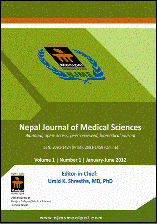Pattern of Mandibular Fractures in Western Region of Nepal
DOI:
https://doi.org/10.3126/njms.v1i1.5798Keywords:
Mandible fracture, etiology, road traffic accidents, patternAbstract
Background: Mandible and nasal bones are the most prominent part of the facial skeleton and are commonly fractured. Its fractures result in severe loss of function and disfigurement. This study was conducted to evaluate and analyze the pattern of mandibular fractures in Western region of Nepal.
Methods: This hospital based, descriptive, cross sectional study included 120 patients treated in the Department of Dental surgery, Manipal Teaching Hospital, Pokhara, Nepal from 1st August 2008 to1st December2011.These patients were examined both clinically and radiologically for mandibular fractures. Data concerning age, gender, causes of fracture and sites of fracture were analyzed.
Results: The age range was 3-80 years (mean26.3±13.43years) and male to female ratio was 1:0.69. Highest frequency was seen in 21-30 years age group. The leading cause of mandibular fracture was road traffic accident (n=56; 46.6%), followed by accidental fall from height or tree (n=28; 23.3%), physical assault (n=18; 15%), sports injuries (n=12; 10%), industrial accidents (n=4; 3.3%) while 2 cases (1.6%) were associated with other causes. The most common site was parasymphysis (n=42; 35%) followed body (n=22; 18.33%), angle (n=20; 16.6%), condyle (n=18;15%) and symphysis (n=10;8.33%).
Conclusion: The study reveals that the majority of the patients were young adult male. The most common etiological factor was road traffic accident and commonly fractured site was the parasymphysis.
Keywords: Mandible fracture; etiology; road traffic accidents; pattern
DOI: http://dx.doi.org/10.3126/njms.v1i1.5798
Nepal Journal of Medical Sciences. 2012; 1(1): 45-48
Downloads
Downloads
Published
How to Cite
Issue
Section
License
Copyright © by Nepal Journal of Medical Sciences. The ideas and opinions expressed by authors of articles summarized, quoted, or published in full text in this Journal represents only opinions of authors and do not necessarily reflect the official policy of Nepal Journal of Medical Sciences or the institute with which the author(s) is (are) affiliated, unless so specified.




